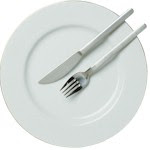Renaissance table manners were crude, to say the least. Dining etiquette included no spitting across the table, or picking ones teeth.
By today’s standards, Renaissance table manners were somewhat…lacking, to say the least. As in Medieval times, diners shared communal dishes, digging in (literally) with their hands. There were no serving utensils, and no silverware. What we think of as “fine manners” (eating with a fork, no burping at the table) did not become fashionable until the 1600s. Those who did exert some type of dining etiquette could expect to be labeled a pretentious snob.
Early Renaissance Table Manners
Through the 1400s, food was served in a long trencher. Wealthy households would have some type of metal trencher, perhaps silver or pewter. Middle class homes would have a metal or wooden trencher. The very poor may have substituted a hollowed out loaf of bread in place of wooden trencher. People would eat from these trenchers, scooping out food with their fingers,
and using bits of bread to sop up juices and broth.
However, the Renaissance was not entirely without table manners. There were a few rules of etiquette that were expected of diners, dating back to medieval times including:
• No spitting across the table.
• No dipping meat directly into the salt dish.
• No picking ones teeth with a finger or knife.
Later Renaissance Table Manners
It was not until the mid 1500s that individual plates and forks were introduced to diners. Henceforth, the common trencher, a staple at European tables for nearly a thousand years, slowly disappeared (though it was probably for the better). People still ate in their kitchens, if they were a peasant or merchant. The wealthy took their meals in the main hall of their estates. Dining rooms would not become popular until the 1700s.
Where does the actual word “etiquette” derive from?
http://library.thinkquest.org
King Louis XIV had drawn up a daily functions, giving time, place and proper dress. It was posted at Versailles as an "etiquette" (spelled with an accent on the first e), a French word meaning "ticket", to help the nobles know what to do. It brought order to court society, and the code of behavior was adopted by the courts of other nation's monarchs"(Source: The World Book Encyclopedia, 2000).
The idea of etiquette rules goes back to the times when people began to live in groups and understood that it was better to get along with one another that to quarrel or fight. The first rules for proper social behaviour were developed in ancient Greece and Rome. Much of today’s formal etiquette originated in the French royal courts in the late seventeenth century. For
example shaking hands is one of earliest forms of etiquette. Giving somebody his hand a warrior wanted to show that he didn't have any weapons and came in peace.
Today many of us worry about etiquette: we need to know what to say and how to behave in a particular situation. Our language and our manners must be appropriate to the situation. Nowadays etiquette doesn't include so many rigid rules, but is more about "everyday living." Its "goal is to help all people of all lifestyles get along with each other." It is more about "common sense and consideration". There are rules which have changed during the centuries, for example, "how men and women interact" has changed considerably since the 1950's (Source: The World Book Encyclopedia, 2000).
Each culture has its own system of etiquette and they are sometimes very different. Behaviour that is proper in one culture may be improper in another. What is considered proper in a city, could be considered improper in a small town.
